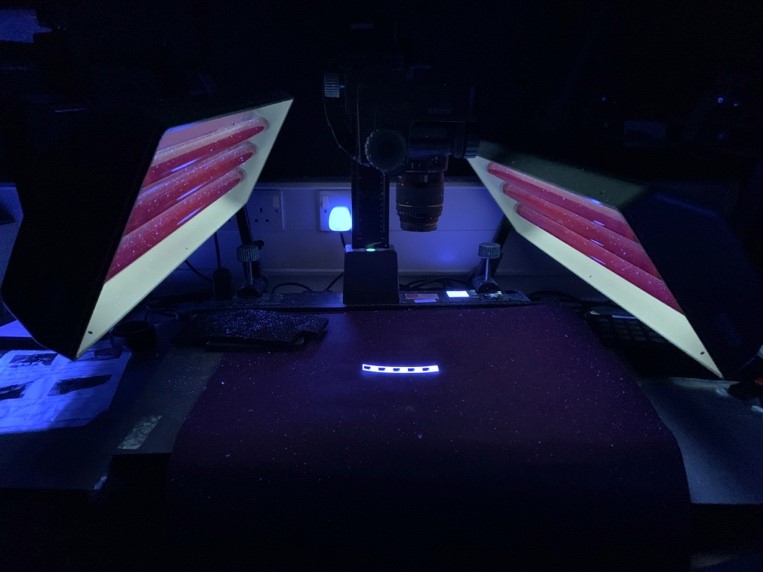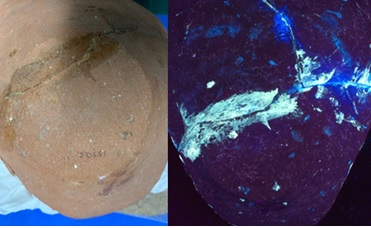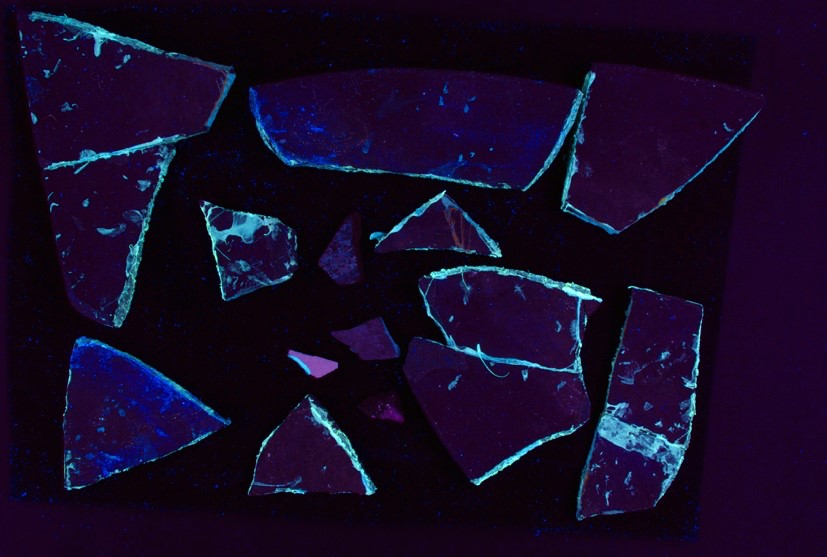UV Huh! What is it good for?
4 January 2020Ultra-violet (UV) light. What’s the first thing that springs to mind when you think about it? Those blacklights used in forensic crime dramas to reveal hidden clues? That episode of Friends with Ross and his blindingly whitened teeth? Or perhaps you’ve heard conservation horror stories about the dangers of UV light and how damaging it can be for objects. As conservators however, UV light is not just something we need to protect objects against, but can actually use as a tool for learning more about them. So, how does it work and what can we use it for?
The reason some materials glow under UV light is down to how the electrons in these materials absorb the invisible UV radiation. The electrons absorb this energy, which excites them to higher energy levels. As the excited electrons slowly return to their lower energy levels, a bit of the energy they absorbed is given back out as visible light, which we see as a glow or “fluorescence” (Hosch, 2009). The way that these electrons react to the UV light determines the colour and strength of visible light that these materials emit.

Conservators can use UV light for a number of different purposes. Sometimes it’s used to identify materials by the distinct colours they fluoresce. Other times it can reveal hidden aspects of the objects themselves; showing up evidence of previous repairs or changes, or sometimes even fakes!
Fluorescence (or the lack of it) in an object can reveal important information that conservators can use to better understand their objects. Because different materials will react to UV light in different ways, there is a wide variety in the types of fluorescence we might see. Thankfully, there are some helpful online tools for interpreting what the various types of fluorescence actually mean. A particularly good one is the Australian Institute for the Conservation of Cultural Materials’ guide to UV fluorescence, which can be found here (https://aiccm.org.au/national-news/summary-ultra-violet-fluorescent-materials-relevant-conservation).

In my case, I ended up deciding to use UV light on my very first object – a large Ancient Egyptian ceramic bowl that had been sent from the Swansea Egypt Centre to Cardiff University for treatment (if you’re interested in learning more about what the Egypt Centre gets up to, give their blog at www.egyptcentrecollectionblog.blogspot.com a visit).
The bowl was in a bit of a sorry state by the time I got it. At some point in its past, it had been broken quite badly and someone had previously tried to stick the pieces back together. Unfortunately, the adhesive they used has aged badly and the bowl is now falling apart again. As no one at the Egypt Centre knew what had been used to repair it, before I could even think about what treatment I was going to do first I had to find out what the adhesive was.

After some research, I had a couple of theories about this, but I didn’t know anything for sure. So I decided to try UV light and see if it could narrow down some of my options.
I used the main set-up that we have at the Cardiff University conservation department, which consists of two UV lamps in the photography dark room in room 2.25, with a camera rig set up to take photographs. Actually using the UV light set-up is pretty easy – switch off the lights, turn the UV lamps on and see if anything glows. You do need to wear UV filtering goggles while using it though – this kind of UV light can be really damaging to your eyes (Measday, 2017)!
To be honest, the main challenge for me here wasn’t using the UV lamps themselves, but really just trying to take photos in the dark! It took me a while to get the hang of finding the right buttons on a camera in the dark, and my first couple of attempts involved a lot of fumbling around and some less than polite words directed towards the camera. I did get the hang of it eventually though – perseverance is key!

The photography I took of my object under UV light ended up being very revealing. Not only did it narrow down the kind of adhesive I was looking at and highlight how much of it was on the surface of the bowl (and oh boy was there a lot!), but it also showed me something unexpected –a second adhesive alongside the first (a deep blue fluorescence, separate from the main adhesive which showed up as a white-ish yellow).
I have to say, I was thrown for a bit. Under normal light all the adhesive had looked the same to me. Finding another one was surprising! It goes to show exactly why doing tests like these are important. You may find that they can reveal unexpected things that can hugely impact how you approach treating your objects. Now I need to factor in a second (currently unknown) adhesive into my future treatment plans. Without doing a UV test though, I may never have even known to look for it in the first place!
If, like me, you think it may be worth looking at your objects under UV light, here are a couple of pros and cons about this test method.
PROS
- It’s a non-destructive technique of testing. That means there’s no need to take any samples and is, in most cases, not damaging or stressful for objects. This is especially handy if your object is quite fragile, or the owners don’t want you to take samples.
- It can reveal things you wouldn’t normally be able to see under regular light, which can give you a whole new perspective on the object you’re treating.
- The results are instant. You can see then and there whether or not there is any fluorescence. If you have lots of different possibilities, looking at an object under UV light can be a good jumping off point to help narrow down your options and better direct your research.
- As diagnostic tests go, this one is fairly easy to do. The equipment itself is pretty simple to use and the results are easier to interpret than some other tests.
CONS
- The results are not as precise as other tests. One type of material might fluoresce a number of different colours, or you may find that there are lots of different materials that all fluoresce the same way.
- It can be quite limited in what it actually tells you. This test only shows you if and how a particular material fluoresces. It won’t tell you what that material is. You will find this a lot in conservation – rarely anything will give you an easy answer. When it comes to testing your objects, it is always good to approach it with some idea of what you’re looking for and it’s usually best to do more than one type of testing to confirm results if possible.
- Although generally quite safe, this test may still cause damage to objects that are particularly sensitive to UV radiation. Exposure to UV light for these types of objects especially should be kept as short as possible.
- And finally, this test doesn’t always work. Other factors can impact how much, if any fluorescence actually shows up. If a material has seriously degraded or is obscured by surface dirt or a material that doesn’t react to UV light, you might not be able to see anything even if the material should fluoresce. Again, this is why you should try and do a couple different types of testing if you can.
As you can see, ultraviolet light isn’t always a conservator’s enemy. I hope this blog post has highlighted how useful UV light can be for conservators and maybe helped you figure out how you can use it to better understand your own objects.

References
Hosch, W.L., “Fluorescence”, (2009). Available at https://www.britannica.com/science/fluorescence
Hubblesite.org, “The Electromagnetic Spectrum. More to Light than Meets the Eye”, (2019). Available at https://hubblesite.org/contents/articles/the-electromagnetic-spectrum
Measday, D., “A Summary of Ultra-Violet Fluorescent Materials Relevant to Conservation”(2017). Available at https://aiccm.org.au/national-news/summary-ultra-violet-fluorescent-materials-relevant-conservation
- March 2024 (1)
- December 2023 (1)
- November 2023 (2)
- March 2023 (2)
- January 2023 (6)
- November 2022 (1)
- October 2022 (1)
- June 2022 (6)
- January 2022 (8)
- March 2021 (2)
- January 2021 (3)
- June 2020 (1)
- May 2020 (1)
- April 2020 (1)
- March 2020 (4)
- February 2020 (3)
- January 2020 (5)
- November 2019 (1)
- October 2019 (1)
- June 2019 (1)
- April 2019 (2)
- March 2019 (1)
- January 2019 (1)
- August 2018 (2)
- July 2018 (5)
- June 2018 (2)
- May 2018 (3)
- March 2018 (1)
- February 2018 (3)
- January 2018 (1)
- December 2017 (1)
- October 2017 (4)
- September 2017 (1)
- August 2017 (2)
- July 2017 (1)
- June 2017 (3)
- May 2017 (1)
- March 2017 (2)
- February 2017 (1)
- January 2017 (5)
- December 2016 (2)
- November 2016 (2)
- June 2016 (1)
- March 2016 (1)
- December 2015 (1)
- July 2014 (1)
- February 2014 (1)
- January 2014 (4)